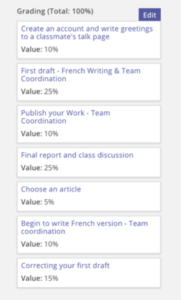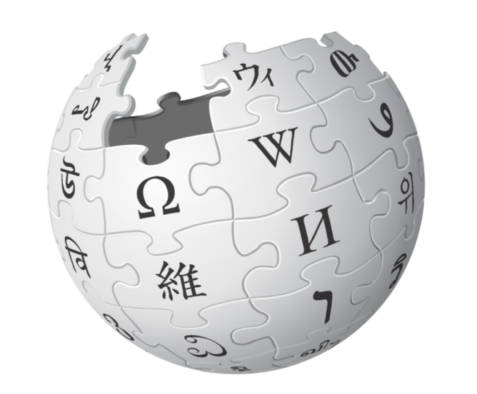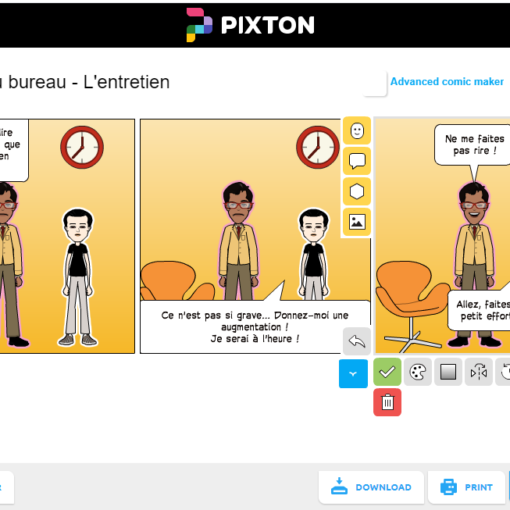Assigning Wikipedia in higher-education courses has become increasingly popular in recent years. Since Wiki Education Foundation was created in 2010, 2,000 courses have been taught through their program, 43,000 students have taken on Wikipedia assignments, and 97% of instructors said they would do it again (as of 2018). What can (and cannot) bring a Wikipedia Translation project to the Second Language classroom?
Pedagogical outcomes
Piotr Konieczny has listed the many benefits for college students contributing to Wikipedia through a scaffolded assignment. In addition to fostering digital literacy, instructors who implemented such an assignment have underscored its ability to increase students’ motivation; foster collaboration and critical thinking skills; and enable students to engage in a socially responsible activity (Konieczny: 2016). In addition, reaching out to communities of native speakers has long been credited for fueling the language learners’ motivation (Dörnyei: 1994). In the most thorough study dedicated to assigning Wikipedia in the Second Language classroom to date, Brian W. King has highlighted how such writing task also develops participant identities as valid writers of texts composed in the target language, not least thanks to the multi-layered readership (King: 2015). Indeed, students contributing to Wikipedia interact not only with the instructor and classmates as peers, but also with the active community of contributors (the “Wikipedians”) and the digital encyclopedia’s extensive readership. My essay also suggests that Wikipedia represents an ideal space to practice what Peter Elbow has coined “low stakes” leading to “high stakes” writing (Elbow 1997).
On the other hand, the prospect of a wide readership, and the completion of an assignment that will initially come across as unusual for many students, may be prone to trigger anxieties — which we know to be the nemesis of language learning. A thorough scaffolding, as well as clearly laid-out pedagogic outcomes and assessment scale — which what follows provides an example of — is instrumental to keep these anxieties at bay and make the most of this “real life” exercise of pedagogical translation.
Editing vs. Translating
Most studies have highlighted the outcomes of editing Wikipedia (i.e., creating or modifying an article). Much fewer, if any, have addressed the specific outcomes of translating Wikipedia. Language instructors, however, may want to consider a Wikipedia translation project thanks to the strong focus on the language the task implies. Besides, although translation has long been strongly discouraged in Foreign Language Acquisition, a number of scholars have set out to expound its many assets. Colina and Lafford have thus cogently argued that:
Translation can facilitate language acquisition on linguistic, textual, cultural, social and motivational grounds by aiding with the acquisition of writing proficiency, facilitating the “noticing” aspect of adult Second Language Acquisition through metalinguistic and cultural awareness and integrating all four skills (reading, writing, listening and speaking) in authentic contexts. The specific roles proposed for translation in this facilitative process are those of a pedagogical tool, a fifth skill (integrated into the curriculum), and a social and motivational element in community and naturalistic settings. (Colina, Lafford 2018, 121)
The assets of translating Wikipedia in the Second Language Classroom are to combine a strong focus on language competencies with cultural and contextual significance, in addition to the specific incentive entailed in writing for a wide readership and in collaboration with native speakers.
A Case Study
Figure 1. Wikipedia Assignment set up on Wiki Education Foundation Dashboard. The instructor can customize this timeline. From https://dashboard.wikiedu.org/courses/Hunter_College/French_202_(Spring_2018)/timeline
In the course of eight weeks, the French class I taught in Spring 2018 translated into French entries of their college and alumni that already existed in English. Their translation work has become an organic part of Wikipédia, as their contributions are still up and regularly edited. Wiki Education Foundation provides valuable tools to help instructors successfully implement such an assignment. The dashboard provides helpful guidelines to set up a week-by-week timeline and a clear breaking up of the final grade. It is user-friendly and greatly helps with scaffolding the assignment throughout the weeks. (Fig. 1). As Fig. 2 suggests, I designed this translation assignment as a truly pedagogical exercise, with different steps of writing, revising, and peer collaboration. Although the timeline and scaffolding will need to be tailored to the learning environment’s specifics, I would like to emphasize two guiding principles which I believe to be helpful in nearly all cases: first, revising as a core learning task and secondly, the value of teamwork.
Revising as a core learning step
A translation exercise is valuable to gain conceptual learning of the language (Yuvayapan: 2016). In practical terms, it means that the reviewing steps are instrumental. Students should be allowed to make mistakes, then be provided with tools to understand and correct them. relatedly, using a correction code is a must. In 2018, I used a hard-copy correction code (Annex). Now, I would certainly use a digital editing tool for greater clarity. It is worth noting that understanding what a correction code is, and how to use it is in itself a skill – a meta-language of sorts – some students may not be familiar with. If this applies to your class, you may want to start using a correction code with earlier, more traditional writing assignments, so the latter will already be a familiar working tool by the time they become involved in more challenging projects.
Translation and Collaborative Learning
Having students work on articles in groups of two or three worked extremely well in my case. I also secured class-time for students to interact about their involvement in Wikipedia at different steps of the assignment:
- In the beginning, as they become familiar with Wikipedia’s environment (talk pages, sandboxes, etc.).
- At mid-point, to discuss the obstacles they were encountering with the translating and reviewing process and the remedies they came up with.
- In the end, to summarize what they have learned and the knowledge they have gained through their contributing and translating experience.

Figure 2. Breaking-up of the translation project’s assessment.
Translating Wikipedia in your Classroom: How to make it work?
Should your students translate to or from their native language(s)? Translating into a native language (the way Wiki Education Foundation recommends) has certainly a pedagogical value of its own. On the other hand, translating into a non-native language bestows a unique opportunity to observe and exchange with a community of native speakers. It also encourages students to build their voice in the target language. Nevertheless, translating Wikipedia into a non-native language remains a challenging assignment and will not work in all second language courses. In order to make an informed decision, here are a few questions language instructors may want to consider.
What is the students’ level of proficiency?
Paolo Balboni reminds us that most European research indicates B2 (on the CEFR guideline) as the threshold level for first translation activities (Balboni: 2017).
How long should the translation be?
Keep it short! When assigning this task to students who were into their 4th semester of French, I capped the individual translation assignment at 400 – 500 words, which was amply enough.
How many students are there in your class?
Wikipedia Education Foundation cogently discourages assigning a Wikipedia translation to more than 30 students. Based on my experience, implementing such an assignment to a 30-student class is doable, but would probably work even better with smaller groups. Indeed, for this assignment to be truly beneficial, students need to be provided sustained guidance through different steps of writing, revising, and editing. Students should submit to their professor and revise their draft (at least once) before publishing their work online, and then be prepared to have their published translation edited by “Wikipedians.” In addition to the classical teacher’s input (proofreading, discussing mistakes and provide tools to revise and improve the draft, etc.), the instructor should also be prepared need to guide students through a technological environment they are not familiar with. Moreover, class-time should be allotted to group activities, “workshopping,” and reflexive class discussions. Beyond the sheer translating exercise, the assignment also belongs to experiential learning. As such, it opens students to a new cultural and technological environment many of them will be eager to discuss further.
How to optimize student engagement with the translating task?
Bearing pedagogical goals in mind, what matters is to select entries whose translation is both doable and thematically relevant or relatable to your students. Many students will be instinctively (and understandably) inclined to translate articles whose topic directly relates to their interests. Unfortunately, those pages (those of a celebrity, a successful TV-show etc.) usually have wide exposure and/or already have a French translation. For first contributions in a non-native language, it is safer to choose articles with less exposure in order to avoid heated reactions from Wikipedians and summary deletions. In my class’ case, in addition to the Hunter College entry[1], I selected prominent alumni from Hunter College (whose Wikipedia entry had not been translated into French yet. Aware of the longstanding underrepresentation of women and people of color on Wikipedia, the selection included prominent scientists, artists, and authors such as US painter Vivian E. Browne[2], civil rights activits Pauli Murray[3], biochemist Mildred Cohn[4], author Bel Kaufman[5], and mathematical physicist Arlie Peters[6]. I then let students choose which article they would work on, thus carving out a space for students’ expression of preference. By doing so, I shall admit that I somehow went against the Wiki Education Foundation’s recommendations. Indeed, the latter warns you against the risks of conflict of interest[7]and academic boosterism[8] entailed in editing the entry of someone from your institution, since there exists a tendency to portray their alma mater in a favorable light. I decided for taking such a measured risk as the temptation of “embellishing” seems reduced in the context of a translation task (as opposed to the creation of an entry ab nihilo). Moreover, it seemed to me that a connection to the topic would nurture students’ engagement. Regardless, the possibilities offered by Wikipedia are nearly endless, and there are certainly other options to explore.
|
An effective strategy regarding Automated Translation Tools |
| Automated translation tools are certainly the nemesis of pedagogical translation, and I am afraid there is no magic recipe to make the problem disappear altogether. However, I found it useful to explain in class the different reasons why language learners are better off staying away from them.
– First, I framed this exercise of translation as a pedagogical training towards greater proficiency; as a learning experience in which the journey is more valuable than the outcome. The assignment’s grading criteria reflected this philosophy, as the intermediary steps of writing and revising had more weight than the final draft (fig. 2). – Secondly, some might turn to automated translation for lack of better options: in my class, a significant number of students did not know how to use online dictionaries (such as wordreference.com) at the onset of the project. Once cognizant of such valuable tools, students usually realize that using they are incomparably more useful for their learning than automated translation. – Thirdly, I provided examples of how wrong automated translation can get. During the class project, I found in the entries the students were working on a particularly eloquent example to illustrate how wrong and problematic automated translation can be (it was an extremely faulty translation of “Black Studies,” as featured in the class materials shared at the end of this piece). Bringing up and discussing this example in class convinced most students to stay away from automated translation tools. |
Conclusion: An Introduction to the Cultural Politics of Translation
As we drew towards the end of the class project, became eager to share their common experience of newly minted translators. Some of the assignment’s highlights occurred during reflexive class discussions in which we addressed the challenges students encountered. Most remarkably, the translation assignment brought to the fore engaging issues relating to the politics of the French language. For instance, many students grappled with the translation of “Black” or “mixed-race”, which led us to a lively discussion about French color-blindness and the historical reasons for it. Likewise, the translation assignment also made the students experience the implications of writing life stories and events in a language in which “le masculin l’emporte.” Doing so engaged students with the stakes of écriture inclusive (the much-discussed French version of gender-neutral language). In addition to opening the students to a more critical approach to the ethical and political stakes underlying the exercise of translation, the lively discussions we held in class also strengthened the class’ sense of community through shared experience, resonant questions, and relatable issues.
Materials
- The Wiki Education Dashboard to design and scaffold the assignment
- In this 25-minute class activity, which is designed for French language learners, students practice Wikipedia translation in groups. This exercise of close reading is aimed to generate discussion about the cultural issues such an exercise of translation raises. It also illustrates some of the problems of automated translation.
- Below is a correction code I used in my French 202 Course. A good editing code lists the most common mistakes students and allows students to learn from their mistakes.
Annex.
| Correction code of Wikipedia Translation assignment (Example) | |
| A | Accord (Agreement) — includes conjugations (you used “il” conj instead of “nous”, etc); you did not agree past participle, etc.) and also plural/ singular, masc/feminine of nouns, adjectives, and articles |
| Acc | Missing or improper Accent |
| Art | Improper article: you used definite art instead of indefinite, partitive, etc. |
| Aux | Auxiliaire — often, “avoir” instead of “être” in passé composé and vice versa. |
| C | Contraction. For instance, you wrote “à les” instead of “aux”. Includes elisions (you wrote “de un” instead of “d’un”) |
| M | Missing Word — often, article or negative word |
| O | Word Order — often, negation word, adjective or adverb |
| P | Préposition — incorrect one or missing: look up Word Reference |
| T | Temps (Tense) – for instance, you used imparfait instead of passé composé. |
| Tr | Traduction — word in English or anglicism |
| V | V = Vocabulaire — inappropriate word or spelling – includes certain errors in conjugations (vous “disez” instead of vous dites, etc) |
| Word or in box | You made a mistake hard to avoid at your current level of proficiency: your instructor gave you the right answer. |
| Word in a box + [WR] | You made a mistake that could have been avoided by a closer look at Word Reference |
| [WR] | Look up Word Reference. |
Footnotes
[1] https://fr.wikipedia.org/wiki/Hunter_College
[2] https://fr.wikipedia.org/wiki/Vivian_E._Browne
[3] https://fr.wikipedia.org/wiki/Pauli_Murray
[4] https://fr.wikipedia.org/wiki/Mildred_Cohn
[5] https://fr.wikipedia.org/wiki/Bel_Kaufman
[6] https://fr.wikipedia.org/wiki/Arlie_Petters
[7] https://en.wikipedia.org/wiki/Wikipedia:Conflict_of_interest
[8] https://en.wikipedia.org/wiki/Wikipedia:Avoid_academic_boosterism
References
Balboni, Paolo E. “Translation in Language Learning: A What For Approach.” Revista EntreLínguas, 2017, Volume 3, Issue 2, 276-299. DOI: 10.29051/rel.v3.n2.2017.9546
Colina, Sonia, Barbara A. Lafford, “Translation in Spanish language teaching: the integration of a “fifth skill” in the second language curriculum.” Journal of Spanish Language Teaching, 2018, Volume 4, no. 2, 110-123, DOI: 10.1080/23247797.2017.1407127
Dörnyei, Zoltán. “Motivation and Motivating in the Foreign Language Classroom.” The Modern Language Journal, 1994, Volume 78, No. 3: 273-284
Elbow, Peter. “High Stakes and Low Stakes in Assigning and Responding to Writing.” New Directions for Teaching and Learning, Spring 1997, no. 69: 5-13
King, Brian W., “Wikipedia Writing as praxis: Computer-mediated socialization of second-language writers.” in Language Learning and Technology, October 2015, Volume 19, no.3, 106 – 123.
Konieczny, Piotr. “Teaching with Wikipedia in a 21st Century Classroom: Perceptions of Wikipedia and Its Educational Benefits”, Journal of the Association for Information, Science and Technology, 2016, Volume 67, no.7; 1523 – 1534
Yuvayapan, Fatma. “A Need for Conceptually Fluent Language Learners: Rethinking the Use of Translation Method in the Teaching of idioms.” International Journal of Languages’ Education and Teaching, 4(3), December 2016, 122-138. Doi: 10.18298/ijlet.591







